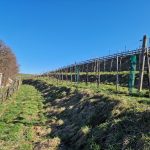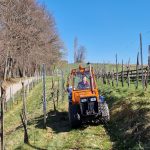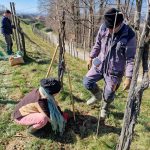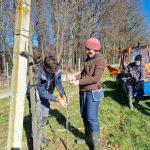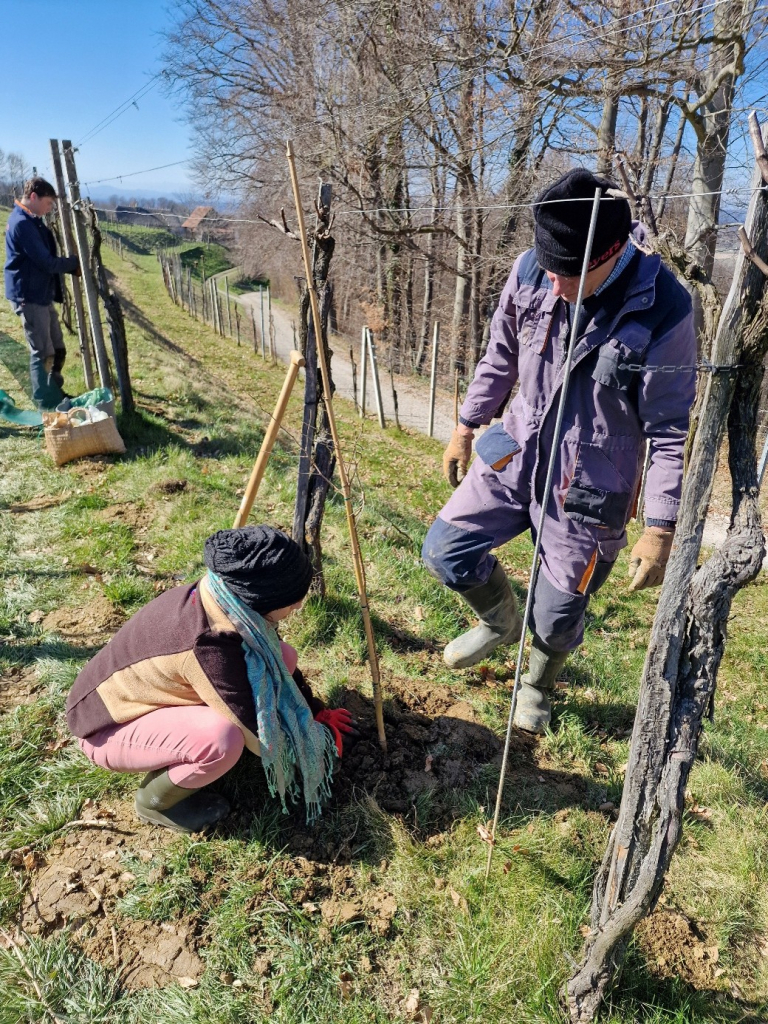In March, members of the University of Maribor Aracne team planted male mulberry varieties “Kokusou 21” and “Cattaneo”, together with some local Slovenian varieties, at the Dorner family’s vineyard in Novi Vrh, located in the Slovenske gorice region of Styria, near the Austrian border. The Dorner family’s vineyard is a historic winery that has been dedicated to organic viticulture since 1976 and reflecting a long-standing commitment to sustainable and environmentally friendly wine production.
Jakob Dorner, together with his brother Elias Dorner, who jointly manage the estate, has long been fascinated by mulberries and their traditional uses. Our collaboration began in 2017 during the Hungarian-Slovenian bilateral project on mulberry inventory. Jakob approached us with a well-developed concept for planting mulberry trees, and we worked together to design the initial plantation approach. The planting follows the traditional La Piantata Veneta practise, integrating mulberries and grapevines into a polycultural system.
The layout was designed based on an existing row of vines, exploring different possibilities for combining mulberries and vines. Various planting distances between mulberry trees were used:
- In first concept, vines are spaced 4 meters apart between mulberries and either left unsupported or trained along a supporting wire.
- A variation also uses a 6.4-meter distance but adds two vines (single-sided cordon) between each pair of mulberries.
- In the third concept, mulberries are spaced 8 m apart, with four vines planted between them.
- In another layout of 6.4 m distance, vines are allowed to climb and wind around the mulberry trees (2) without being connected to one another.
Schematic demonstration of vine planting along mulberry trees (illustration by Jakob Dorner).
The La Piantata Planting Concept
The traditional agricultural practice of cultivating plots surrounded by rows of vines planted next to tall trees, known as “La Piantata Veneta”, was included in the (Italian) National Register of Rural Landscapes with Agricultural Practises and Traditional Knowledge (2018).
This traditional agricultural practice rooted in ancient Etruscan and Roman farming systems, embodies a sophisticated and harmonious approach to land cultivation that has stood the test of time. At its core lies a form of polyculture, where three complementary plant types are intercropped: grapevines that climb and weave their way up tall support trees like mulberries, peaches, or elms; the trees themselves, which offer not only structure but also fruit, wood, and pasture; and a ground-level layer of crops, typically cereals, vegetables, or grasses, that enrich the soil and provide seasonal food.
This multi-layered system reflects a deep understanding of natural synergies. Each plant has a role: the vines benefit from the natural trellis of the trees; the trees protect the soil and help regulate water; and the herbs and grasses improve biodiversity and soil health. Over centuries, this co-cultivation model has proven both ecologically efficient and economically resilient.
By the 18th and 19th centuries, the practice evolved into La Piantata Veneta, incorporating advanced hydraulic systems for water management. This was especially valuable when rural rent was paid in kind, allowing farmers to harvest multiple crops from a single plot throughout the year. The system even included legumes to naturally enrich the soil—an early example of conservation agriculture.
With the growth of the sericulture, mulberries became central to this system, supplying leaves for silkworms. Despite the specialization, plant diversity was maintained, and methods for training vines on trees were widely documented in 19th-century manuals.
Today, La Piantata is more than a historical model—it is a protected cultural landscape. One outstanding example is the ancient vineyard of Baver in Godega di Sant’Urbano maintained by the Fabris family (link). It continues to provide ecosystem services like wind protection, erosion control, fruit and timber production, and tourism value.
These cultivation practice was also present in Lower Styria (territory of Slovenia) in the 18th and 19th century following the Italian model. Large plantations were established on estates such as Novo Celje, known as “Styrian Eden,” for their superior cultivation practices of horticultural trees and vineyards in the tradition of La Pientata Veneta. However, wars, agricultural crises, and low silk prices led to a decline by the late 19th century.
Scheme of mulberry plantation and tree arrangement at the Novo Celje mansion. (Source: Zimmerman 2016)
La Piantata stands as a compelling model for sustainable and biodiverse agriculture, offering valuable lessons from traditional knowledge that remains relevant today.
The Dorner Family Estate and Their Commitment to Organic Viticulture
The Dorner family estate, located in Novi Vrh of Slovenske gorice, near Mureck on the Austrian border), has been a pioneer of organic viticulture since 1976.
The vineyard, established in 1865, lies in a region historically shaped by the shifting borders of the Mur River. Following World War I, newly drawn national boundaries disrupted many communities—including the Dorners, who faced challenges accessing their vineyard. Despite these difficulties, the family preserved their legacy and land.
In the 1970s, Dieter Dorner, motivated by a strong environmental ethic, began the transition to organic farming, making the estate one of the oldest certified organic wineries in Styria. His commitment laid the foundation for a viticultural philosophy rooted in ecological balance, long before organic farming gained wider recognition.
Today, the Dorner family continues this legacy by cultivating a diverse collection of PIWI grape varieties, which are naturally resistant to fungal diseases and reduce the need for chemical treatments. Their vineyard is more than rows of vines—it is a living mosaic of biodiversity. Wild fruit trees such as cornel (Cornus mas), hawthorn (Crataegus), almond trees (Prunus dulcis), and ancient apple and pear varieties are planted as ecological corridors, serving as natural buffers, pollinator habitats, and for beneficial insects.
Rather than relying on synthetic herbicides or fertilizers, the Dorners use alternative mulching, cover crops, and rotational grazing with dwarf sheep to manage weeds and regenerate the soil. These methods not only preserve soil structure and fertility but also support microbial life, encouraging a vibrant and self-sustaining ecosystem.
Set on the clay-sandy soils of Neuberg / Novi Vrh, the vineyard is carefully maintained without synthetic pesticides or fertilizers. Every procedure, from the choice of plant species to the timing of interventions, is guided by a deep understanding of how biodiversity enhances resilience. Pest pressures are kept in check through natural predation, soil erosion is prevented by continuous ground cover, and carbon is sequestered through perennial vegetation.
For the Dorner family, organic farming is not just an agricultural practice. It is a way of life that integrates tradition, innovation, and ecological responsibility. Their vineyard stands as a compelling example of how biodiversity-based viticulture can deliver not only high-quality wines but also essential ecosystem services, ensuring the health of the land for generations to come.
For more information or to explore their products, visit their official website: www.weingut-dorner.at
Andreja Urbanek Krajnc, University of Maribor
Faculty of Agriculture and Life Sciences
